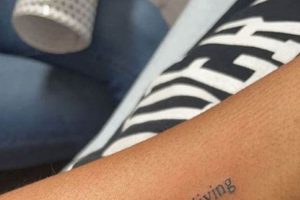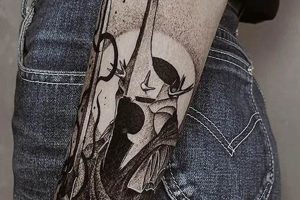Tattoos designed for individuals of African descent often incorporate cultural and historical elements reflecting their heritage. These designs may feature Adinkra symbols, portraits of influential figures, representations of African wildlife, or patterns inspired by traditional textiles and body art. Examples include depictions of Sankofa birds symbolizing learning from the past, or geometric patterns reminiscent of Kente cloth.
Such designs can serve as powerful expressions of personal identity, allowing individuals to connect with their ancestry and celebrate their cultural heritage. They can also be statements of empowerment, resilience, and pride. Historically, body art and scarification held deep cultural significance in various African communities, serving as markers of identity, status, or spiritual beliefs. Contemporary tattooing can be seen as a modern continuation and reinterpretation of these traditions.
Further exploration of this topic will delve into specific design motifs, the symbolism they carry, the artists specializing in this style, and considerations for those seeking such tattoos.
1. African Symbolism
African symbolism plays a crucial role in tattoo designs for people of African descent, offering a powerful means of connecting with heritage and expressing identity. These symbols, drawn from various African cultures, carry deep meaning and historical significance, enriching the narrative expressed through body art.
- Adinkra Symbols
Originating from the Akan people of Ghana and Cte d’Ivoire, Adinkra symbols represent concepts like wisdom, strength, courage, and hope. The Sankofa bird, symbolizing learning from the past, is a popular choice. These symbols offer visually compelling designs while imbuing the tattoo with profound cultural meaning.
- Nkisi Nkondi Power Figures
These figures from the Kongo culture are traditionally used in spiritual practices and represent protection and power. In tattoo form, they can symbolize resilience, ancestral connection, and spiritual strength. Their intricate designs translate well into striking body art.
- Egyptian Hieroglyphs
Drawing from ancient Egyptian civilization, hieroglyphs represent various concepts, deities, and pharaohs. Incorporating these symbols into tattoos can represent knowledge, spirituality, and a connection to a rich historical legacy.
- West African Scarification Patterns
While not strictly symbols, traditional scarification patterns from West African cultures provide inspiration for tattoo designs. These patterns, historically used for identification and beautification, can be reinterpreted in tattoo form to honor ancestral traditions and express cultural pride.
By incorporating these and other African symbols, individuals can create tattoos that are not only aesthetically pleasing but also deeply meaningful, reflecting their connection to a rich and diverse cultural heritage. The choice of symbol often reflects personal values, beliefs, and a desire to honor ancestral traditions.
2. Portraits of Icons
Portraits of prominent figures serve as powerful statements of identity and admiration within the realm of tattoos for individuals of African descent. These portraits often depict historical figures, civil rights leaders, musical artists, writers, and other influential individuals who have shaped and inspired Black culture and communities worldwide. Choosing to permanently etch these icons onto one’s skin reflects deep respect, celebrates their legacy, and serves as a source of personal inspiration.
- Historical Figures
Depictions of historical figures like Nelson Mandela, Harriet Tubman, or Martin Luther King Jr. represent resilience, leadership, and the ongoing struggle for equality and justice. These tattoos serve as reminders of the sacrifices made by these individuals and inspire continued activism and social change.
- Cultural Icons
Portraits of influential musicians like Bob Marley, Fela Kuti, or Nina Simone celebrate artistic expression and cultural impact. These tattoos represent the power of music to inspire, uplift, and reflect the experiences of Black communities. They can also honor the artists’ contributions to social and political movements.
- Literary Figures
Tattoos featuring writers like James Baldwin, Toni Morrison, or Chinua Achebe highlight intellectual contributions and the power of storytelling. These portraits celebrate literary achievements and the exploration of complex themes related to race, identity, and the human experience.
- Contemporary Figures
Portraits of contemporary figures, such as athletes, activists, and artists, reflect current inspirations and role models. These tattoos may represent excellence in a particular field, advocacy for social justice, or contributions to contemporary Black culture. They demonstrate an appreciation for current achievements and ongoing contributions.
Ultimately, portrait tattoos of icons within the Black community represent a powerful way to connect with history, celebrate achievements, and express personal values. They serve as visual reminders of the individuals who have shaped and continue to inspire generations, fostering a sense of pride, belonging, and empowerment.
3. Afrocentric Patterns
Afrocentric patterns hold significant relevance within the context of tattoo designs for individuals of African descent. These patterns, derived from traditional African textiles, art forms, and architecture, offer a visual connection to ancestral heritage and cultural identity. Incorporating these patterns into tattoo designs allows individuals to express pride in their roots and celebrate the rich artistic traditions of the African diaspora. The use of these patterns contributes to a broader movement of reclaiming and celebrating African aesthetics and cultural heritage. For example, incorporating kente cloth patterns, with their vibrant colors and geometric designs, can symbolize royalty, status, and cultural pride.
The significance of Afrocentric patterns extends beyond mere aesthetics. These patterns often carry symbolic meaning, representing specific concepts or values within different African cultures. For instance, Adinkra symbols, often incorporated into patterns, convey messages of wisdom, courage, and hope. The incorporation of these symbols adds another layer of depth and meaning to the tattoo, allowing individuals to express personal values and beliefs through a visually compelling medium. Furthermore, the choice of specific patterns can reflect regional or ethnic affiliations, allowing for a more nuanced expression of identity. For example, incorporating patterns inspired by Nuba body painting traditions can connect individuals to specific ancestral lineages and cultural practices.
In summary, Afrocentric patterns provide a powerful means of expressing cultural identity and personal narratives within the context of tattoo art. They offer a visual link to ancestral heritage, carry symbolic meaning, and contribute to a broader movement of cultural affirmation. By understanding the historical and cultural context of these patterns, individuals can create tattoos that are not only aesthetically pleasing but also deeply meaningful and representative of their unique identity within the African diaspora.
4. Natural Hair Textures
Natural hair textures hold profound significance within the realm of tattoo designs for individuals of African descent. These textures, ranging from tightly coiled curls to loose waves, represent a powerful statement of identity, self-acceptance, and cultural pride. Historically, natural hair has been subject to societal pressures and Eurocentric beauty standards, often leading to chemical straightening and other forms of alteration. The choice to embrace and celebrate natural hair textures through tattoo art signifies a reclamation of beauty standards and a rejection of these historical pressures. Tattoos depicting natural hair textures, whether stylized or realistic, serve as visual affirmations of self-love and cultural pride. They can also symbolize resistance against societal norms and a celebration of individuality.
The depiction of natural hair in tattoo art takes various forms. Some individuals opt for stylized representations, incorporating patterns and symbols that evoke the texture and shape of natural hair. Others choose realistic portraits that showcase the intricate details and beauty of different curl patterns, braids, and locs. These tattoos can be incorporated into larger designs, such as portraits of individuals or symbolic representations of African heritage, or they can stand alone as powerful statements of self-acceptance. The choice of style often reflects personal preferences and the specific narrative the individual wishes to convey. For example, a tattoo featuring intricately detailed braids might symbolize a connection to family traditions and cultural heritage, while a stylized Afro might represent a broader celebration of Black identity and empowerment. These depictions contribute to a growing movement of celebrating natural beauty and challenging conventional beauty standards.
In summary, the incorporation of natural hair textures into tattoo designs reflects a significant shift in cultural attitudes and a growing embrace of self-love and cultural pride within the Black community. These tattoos serve as powerful symbols of identity, resilience, and the ongoing celebration of natural beauty. They represent a reclamation of cultural narratives and a rejection of historical pressures to conform to Eurocentric ideals. Through this art form, individuals can express their unique identities and contribute to a broader movement of self-acceptance and cultural affirmation.
5. Inspirational Quotes
Inspirational quotes hold significant weight in the context of tattoo designs for individuals of African descent. These quotes, often drawn from literature, music, speeches, and proverbs, serve as powerful affirmations of identity, resilience, and cultural pride. Incorporating these textual elements into tattoo designs allows individuals to express personal values, connect with historical narratives, and celebrate the rich literary and oral traditions of the African diaspora. Choosing to permanently inscribe these words onto one’s skin reflects a deep connection to the message conveyed and a desire to carry that inspiration throughout life.
- Empowerment and Self-Love
Quotes emphasizing self-love, empowerment, and resilience resonate deeply within the context of Black identity. Phrases like “I am enough,” “Black is beautiful,” or excerpts from Maya Angelou’s poetry, for example, serve as powerful reminders of self-worth and celebrate the beauty and strength of Black individuals. These tattoos can be particularly meaningful for individuals navigating experiences of racism or discrimination, providing a constant source of affirmation and strength.
- Honoring Ancestral Legacy
Quotes from historical figures, proverbs, or traditional songs connect individuals to their ancestral heritage and cultural roots. Words of wisdom from figures like Nelson Mandela or Marcus Garvey, for example, offer guidance and inspiration drawn from historical struggles and triumphs. These tattoos serve as reminders of the sacrifices made by previous generations and inspire continued activism and social change. They also connect individuals to a larger historical narrative and foster a sense of belonging and cultural pride.
- Celebrating Black Excellence
Quotes celebrating Black excellence in various fields, from arts and sciences to sports and activism, highlight achievements and inspire future generations. Words from influential figures like W.E.B. Du Bois or Toni Morrison, for instance, can inspire intellectual curiosity and artistic expression. These tattoos serve as reminders of the vast contributions of Black individuals to society and can foster a sense of pride and aspiration.
- Promoting Unity and Social Justice
Quotes promoting unity, equality, and social justice reflect a commitment to collective action and positive change. Phrases like “Black Lives Matter” or excerpts from speeches by Martin Luther King Jr., for example, serve as calls to action and affirmations of solidarity. These tattoos represent a commitment to social justice and can inspire individuals to engage in activism and advocacy work. They also create a sense of community and shared purpose.
By incorporating inspirational quotes, individuals create tattoos that not only adorn the body but also nourish the mind and spirit. These textual elements add depth and meaning to tattoo designs, allowing individuals to express personal values, connect with historical narratives, and celebrate the power of language to inspire and uplift. The choice of quote often reflects personal experiences, beliefs, and aspirations, making each tattoo a unique and powerful expression of identity within the broader context of Black culture and experience.
Tips for Choosing Meaningful Tattoos
Careful consideration ensures a tattoo resonates with personal values and cultural significance. The following tips offer guidance for individuals exploring tattoo designs that reflect their heritage and identity.
Tip 1: Research Symbolism: Thoroughly research the meaning and origins of chosen symbols. A deep understanding ensures the design aligns with intended messaging. For example, understanding the specific meaning of an Adinkra symbol before incorporating it into a tattoo ensures its cultural significance is honored.
Tip 2: Collaborate with Skilled Artists: Seek artists specializing in Afrocentric designs. Their expertise ensures culturally sensitive and aesthetically compelling representations. An artist experienced in working with diverse skin tones can also optimize the visual impact of the tattoo.
Tip 3: Consider Placement and Size: Thoughtful placement and sizing enhance the visual impact and personal meaning of the tattoo. A larger, more intricate design might suit the back or chest, while smaller, symbolic designs might be better suited for the wrist or ankle. Consider the visibility and how it aligns with personal preferences.
Tip 4: Reflect on Personal Narratives: Infuse designs with personal narratives and experiences. This creates a unique and deeply meaningful piece of body art. Incorporating elements representing family history, personal achievements, or significant life events adds depth and emotional resonance.
Tip 5: Prioritize Skin Health: Consult a dermatologist before getting a tattoo, especially on darker skin tones. This ensures appropriate aftercare and minimizes potential complications like keloid scarring. Choosing reputable tattoo studios with high hygiene standards also contributes to positive healing outcomes.
Tip 6: Embrace the Journey: View the tattooing process as a journey of self-discovery and cultural exploration. Engage in open communication with the artist throughout the design process to ensure the final result aligns with personal vision and cultural values. This collaborative approach fosters a meaningful and enriching experience.
By following these tips, individuals can make informed decisions, ensuring their tattoos become powerful expressions of personal identity, cultural pride, and ancestral heritage. Careful planning and collaboration with skilled artists result in meaningful and visually stunning works of art that resonate for years to come.
These considerations provide a foundation for creating tattoos that not only adorn the body but also tell a story, reflecting a deep connection to heritage, personal values, and the ongoing journey of self-discovery.
Frequently Asked Questions
This section addresses common inquiries regarding tattoo designs relevant to individuals of African descent, offering clarity and guidance for those exploring this form of self-expression.
Question 1: What are some culturally significant symbols to consider?
Adinkra symbols, originating from Ghana and Cte d’Ivoire, offer a rich visual vocabulary representing concepts like wisdom, courage, and hope. Other meaningful symbols include Nkisi Nkondi power figures from the Kongo culture and ancient Egyptian hieroglyphs.
Question 2: How can one find a skilled artist specializing in Afrocentric designs?
Online portfolios, social media platforms, and recommendations from within the community can help locate artists specializing in these designs. Reviewing their previous work ensures stylistic compatibility and cultural sensitivity.
Question 3: Are there specific considerations for darker skin tones?
Consulting a dermatologist before getting a tattoo is crucial, especially for darker skin tones. This helps address potential concerns like keloid scarring and ensures appropriate aftercare. Artists experienced with diverse skin tones understand how colors react and can optimize visual impact.
Question 4: How can one incorporate personal narratives into tattoo designs?
Meaningful elements from personal histories, family traditions, or significant life events can be woven into the design. This creates a unique and deeply personal piece of art reflecting individual experiences.
Question 5: What is the significance of depicting natural hair textures in tattoos?
Representations of natural hair, whether stylized or realistic, celebrate self-acceptance and cultural pride. They challenge Eurocentric beauty standards and affirm the beauty of natural hair in its diverse forms.
Question 6: How can one ensure the chosen design remains meaningful over time?
Thorough research, thoughtful reflection, and collaboration with a skilled artist contribute to a design’s lasting significance. Choosing designs that resonate deeply with personal values and cultural identity ensures their enduring meaning.
Careful consideration of these questions empowers individuals to make informed decisions, resulting in tattoos that serve as powerful expressions of identity, heritage, and personal narratives.
Further exploration of this topic might include consultations with tattoo artists, community members, and cultural experts to gain deeper insights and personalized guidance.
Conclusion
Exploration of tattoo designs for individuals of African descent reveals a rich tapestry of cultural symbolism, historical narratives, and personal expressions. From Adinkra symbols and portraits of iconic figures to Afrocentric patterns and representations of natural hair textures, these designs offer powerful avenues for connecting with heritage and celebrating identity. Careful consideration of design elements, collaboration with skilled artists, and a deep understanding of cultural significance ensure tattoos become meaningful and enduring works of art.
These designs serve as powerful statements of self-love, resilience, and cultural pride, contributing to a broader movement of reclaiming and celebrating Black aesthetics and narratives. As individuals continue to explore and express their identities through this art form, the evolution of these designs promises to further enrich the tapestry of Black cultural expression.







